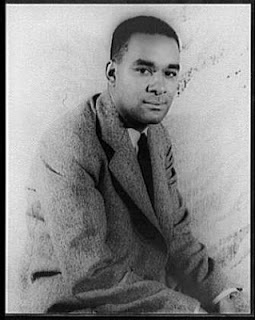This content is being reviewed in light of recent changes to federal guidance.
Project HBW Blog
Richard Wright
Citation
"Richard Wright," History of Black Writing (blog),
, https://hbw.ku.edu/blog/richard-wright
 Following yesterday’s entry on Ralph Ellison, I am concluding this week on Richard Wright as I offer up a few notes on how Wikipedia portrays his biographical page. On last week, I examined how his novel Native Son—a novel in the “100 Novels Collection>” (link expired)—was presented on Wikipedia to multiple internet users.
Following yesterday’s entry on Ralph Ellison, I am concluding this week on Richard Wright as I offer up a few notes on how Wikipedia portrays his biographical page. On last week, I examined how his novel Native Son—a novel in the “100 Novels Collection>” (link expired)—was presented on Wikipedia to multiple internet users.
Since Wikipedia comes up first when searching names on Google and other search engines, I found it necessary to examine these representations. I encourage those reading to pay attention to the Wikipedia developments so we can more readily assess how the site is influencing larger impressions of African American writers and their work.
What Wikipedia Taught Me About Richard Wright:
- I learned that Wright lived with his maternal grandmother in Jackson, Mississippi from early 1920 until late 1925. Here he felt stifled by his aunt and grandmother, who tried to force him to pray that he might find God.
- I learned that in 1923, Wright excelled in grade school and was made class valedictorian of Smith Robertson junior high school.
- I learned that at the age of 15 years, Wright penned his first story, “The Voodoo of Hell’s Half-Acre”. It was published in Southern Register, a local black newspaper.
- I learned that Wright moved to Chicago in 1927. After finally securing employment as a postal clerk, he read other writers and studied their styles during his time off.
- I learned that Wright formally joined the Communist Party in late 1933 and as a revolutionary poet wrote numerous proletarian poems (“I Have Seen Black Hands”, “We of the Streets”, “Red Leaves of Red Books”, for example), The New Masses and other left-wing periodicals.
- I learned that by1935, Wright had completed his first novel, Cesspool, published as Lawd Today (1963), and in January 1936 his story “Big Boy Leaves Home” was accepted for publication in New Caravan.
- I learned that in 1937, Richard Wright moved to New York, where he forged new ties with Communist Party members and began work on the WPA Writers’ Project guidebook to the city, New York Panorama (1938), and wrote the book’s essay on Harlem.
- I learned that Wright became the editor of and wrote over two hundred articles for the Daily Worker and helped edit a short-lived literary magazine New Challenge.
- I learned that Wright gained national attention for the collection of four short stories titled Uncle Tom’s Children (1938) that won him Guggenheim Fellowship, which allowed him to complete Native Son.
- I learned that Wright moved to Paris in 1946, and became a permanent American expatriate.
- I learned that He was invited to join the Congress for Cultural Freedom, which he rejected, correctly suspecting that it had connections with the CIA.
- I learned that The CIA and FBI had Wright under surveillance starting in 1943. Due to McCarthyism, Wright was blacklisted by Hollywood movie studio executives in the 1950s, but, in 1950, starred as the teenager Bigger Thomas (Wright was 42) in an Argentinian film version of Native Son.
- I learned that Wright received several different literary awards during his lifetime including the Spingarn Medal in 1941, the Guggenheim Fellowship in 1939, and the Story Magazine Award.